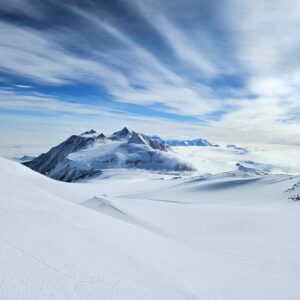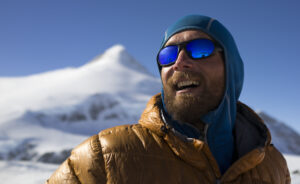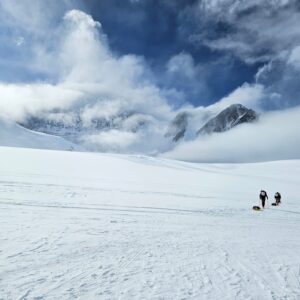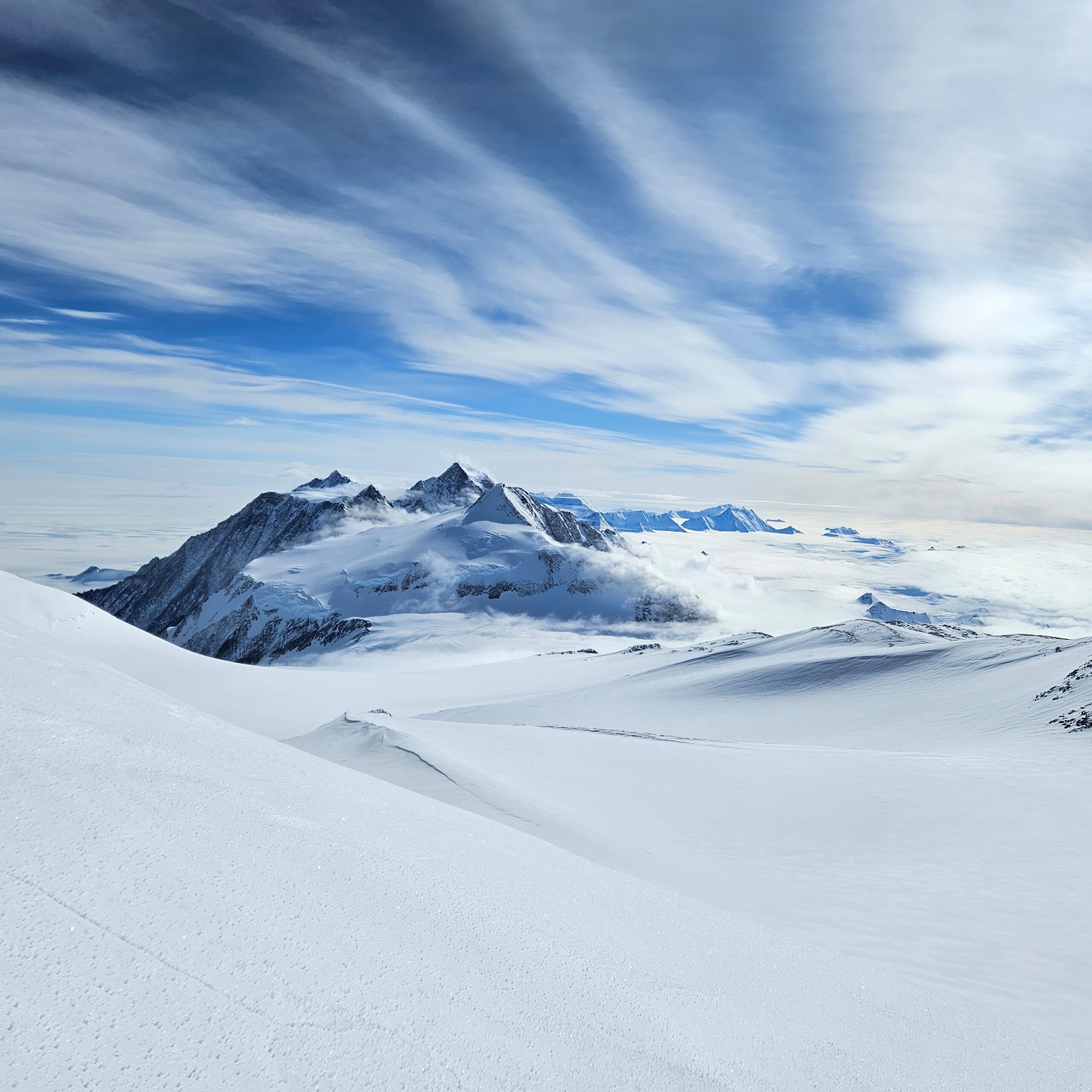
Mount Vinson is Antarctica’s highest peak, and one of the Seven Summits. With a prominence of 16,050ft (4,892m) and residing in one of the world’s most formidable cold deserts, this peak was first summited in 1966, making it the last of the Seven Summits to be reached. Today, over 3,500 people have successfully summitted Mount Vinson as it rises in popularity. To learn about Mt. Vinson and the unique environment in which it resides, we sat down with Vinson guide Nathan Opp, who has worked with ALE for the past ten seasons. He also works as a senior guide for Jackson Hole Mountain Guides and Alaska Mountaineering School. His climbing highlights include the Himalayas, Patagonia, and over 30 expeditions in the Alaska range. We sat down with him to learn about his experience guiding and all things Vinson and Antarctica mountaineering.

ALE guide Nate O. wearing hoody, sunglasses and parka, at Vinson High Camp. Mount Shinn in the background.
Q: Why did you decide to pursue guiding in Antarctica?
A: It’s basically the end of the earth. It’s the last unexplored continent. How much cooler does it get?
Q: Tell us what Vinson basecamp is like?
A: There are clusters of tents for people to spend the night in, and there’s an airstrip nearby so airplanes fly in and out once in a while. It’s just like a normal basecamp…but with airplanes.
Q: What advice do you have for someone looking to climb Mount Vinson?
A: I’d advise you to get a lot of relevant experience. Get a lot of glaciated climbing under your belt. Climb in cold places to get used to that environment. Places like Rainier, Denali, Alaska, Himalayas, anything like that. Oh, and get used to carrying big backpacks.
Q: How does the cold environment make it so unique?
A: The cold makes it even more important to pick the right weather window. If the temperature is closer to freezing, the wind is not going to have nearly as significant an impact as when it’s 20-40 degrees below freezing. A 20mi/h wind when it’s far below freezing is going to be way more difficult to handle than when it’s closer to freezing, so you really need to pick the right day. That’s the trick with Mount Vinson, because on a nice day, it can be great, but a much colder or windier day is less ideal.
Q: What are the stages of climbing Vinson?
A: Most often, it’s divided into 3 stages. You go from Basecamp to low camp, then low camp to high camp. Then your summit day and back down (if weather allows).
Q: If you’re up at high camp and the weather isn’t ideal for summitting, do you stay? How long have you been up at high camp?
A: Correct. I’ve been at high camp at least eight days a couple of times. Maybe even a little more. Yeah, I’ve done that at least twice, maybe three times.

Q: What would you say to someone who’s been thinking about doing Vinson but they’re not sure. What would you tell them?
A: I’d say it’s important to answer why you want to do it. Climbing Vinson doesn’t solve all the world’s problems. It’s very personal, and there is no right or wrong reason. Just be honest with yourself about why you want to do it. I try to ask myself that question too, and I’ve switched a lot of what I do in the last several years because of that. I ask myself if I’m doing this because I want to tell people I did it or do I just actually want to do it.
Q: Tell me about your experience being a ranger on Mt. Vinson?
A: It’s like guiding but a little slower because instead of just going to the top and going down, you wait for everybody to go to the top and make sure everything’s going according to plan, and people are not littering. You’re not really extra help, but you’re there in case of emergency. I like the variety between guiding and being a ranger.
Q: What makes a great guest?
A: First, someone who’s physically capable. Second, honesty – sharing the same goal and vision, and being upfront with what they want from the start.
Q: Do you get tired of guiding Vinson over and over again?
A: No. Vinson is a fun one to do over and over. It’s pretty, it’s different. It’s unique. There’s actually a significant amount of vertical from Basecamp to the top. There’s nowhere else in the world that you can just look at nothingness for. And the ridge at the top you walk through some pretty cool rocks and it’s the prettiest part by far.
Q: What do you like about climbing?
A: I like the focus that it takes, not just in the moment but the preparation, and how you plan, and everything you put into your goals. Also I think what drives me to climb is the physical aspect – it’s a good physical outlet and it kind of takes everything: physical, emotional, mental, perseverance, dedication, and I like that. Oh, and I like getting to the top of things.
Q: What keeps you coming back to ALE to guide?
A: I think anyone who’s worked here over any amount of time would say it’s the group of people that keep you there. They’re all great and a little bit weird and a little separated from modernization of the world and want to explore. I call them my ‘edge of the earth’ friends. All the way from the owners to the people doing the dishes and the guides and in-between, everyone’s searching for something.
Q: What do you do in the off season?
A: I’ve worked in the Tetons and in the United States in the summertime and Alaska in springtime. So that’s been a pretty good circuit.





